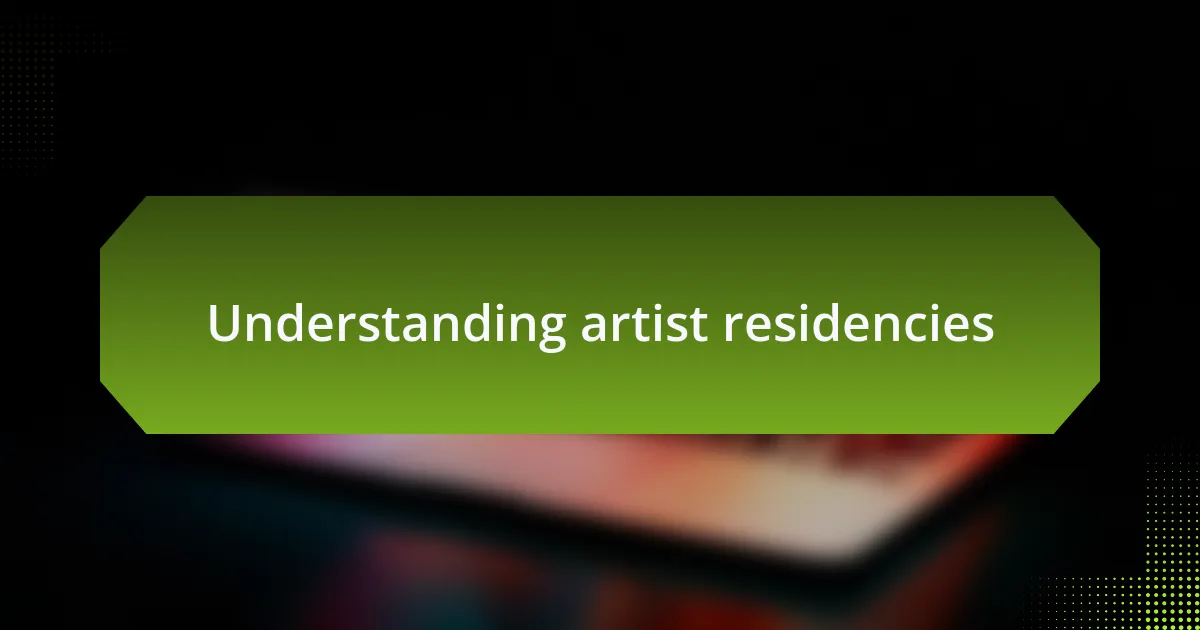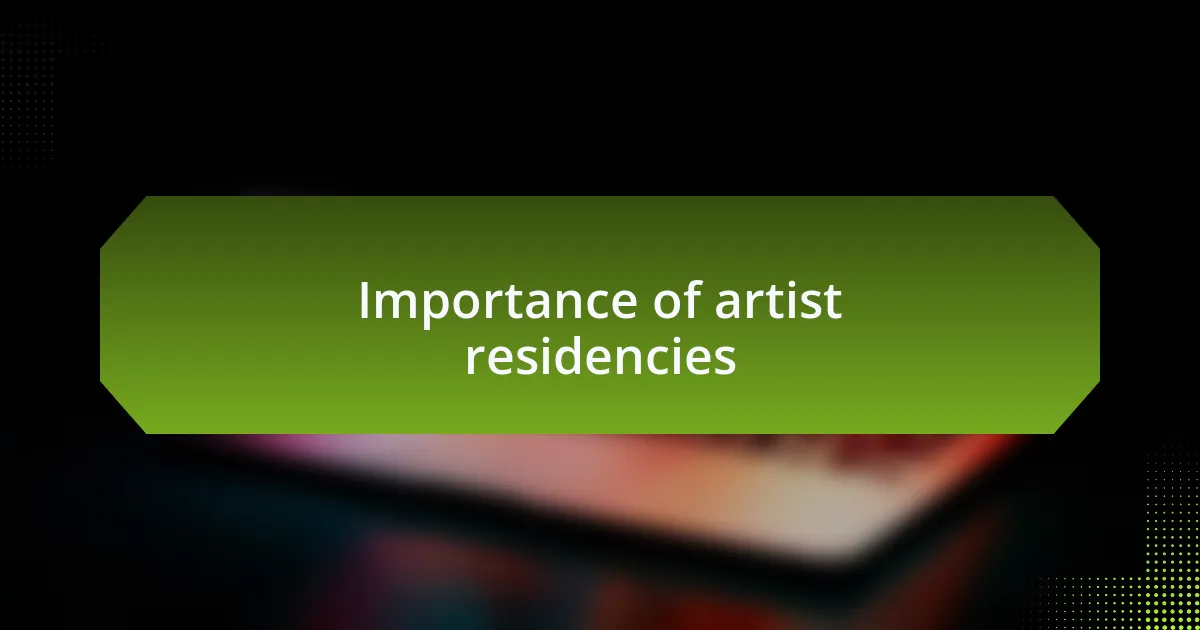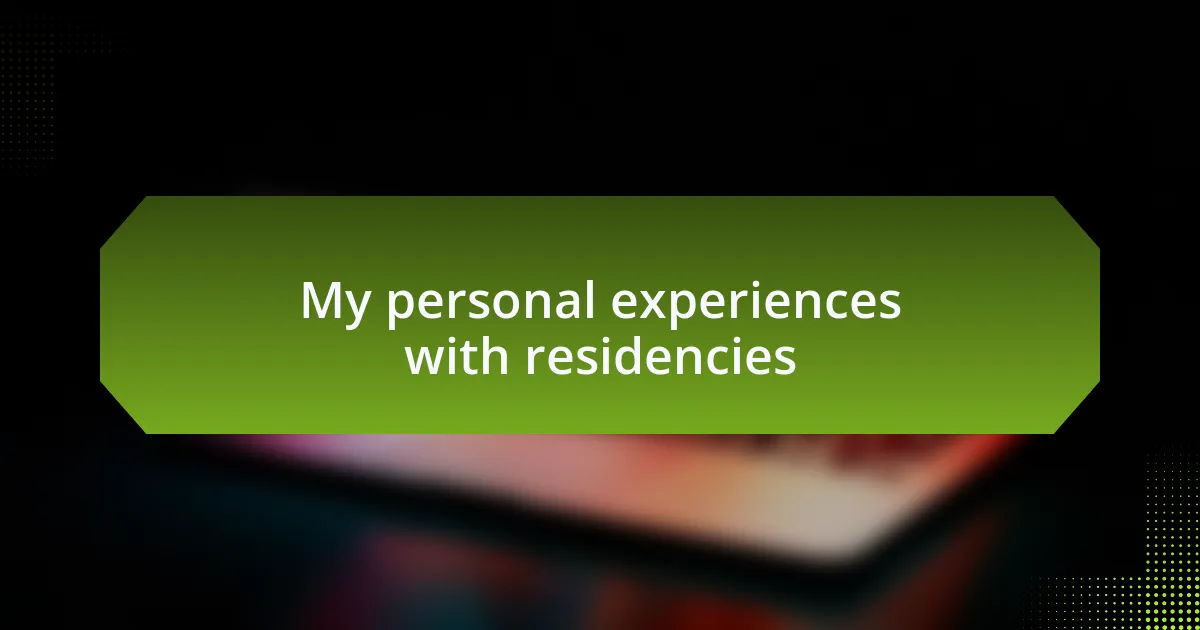Key takeaways:
- Artist residencies offer vital opportunities for creativity, collaboration, and personal growth, enabling artists to explore new mediums and ideas.
- Networking and community engagement during residencies can lead to lasting relationships and enhance artistic practices.
- The application process requires attention to detail, with a strong emphasis on personal storytelling to make applications stand out.
- Key lessons from residencies include the importance of time management, setting intentions, and exercising patience in the creative journey.

Understanding artist residencies
Artist residencies are unique programs designed to provide artists with time, space, and often resources to focus on their creative work. During my own residency, I discovered how invaluable it is to immerse oneself in an environment specifically tailored for artistic exploration. It’s amazing how being surrounded by other creatives can spark inspiration and foster collaboration—have you ever felt that rush of ideas when in the right atmosphere?
Moreover, residencies can vary greatly in their offerings. Some provide mentorship, access to workshops, or even financial support, while others might prioritize solitude and self-directed projects. I remember feeling both nervous and excited at the start of mine, as the uncertainty of what I would produce loomed over me. Did I have it in me to make something significant? That initial fear transformed into a profound sense of freedom as I realized the only expectation was to explore my creativity without limitations.
Participating in an artist residency can also open doors to opportunities that may not have existed otherwise. I found that networking with fellow artists and engaging with local communities can significantly enrich your practice. Have you ever thought about how such connections could influence your path? The friendships and collaborations I formed during my residency continue to resonate in my work today, reminding me that the journey of an artist is often as impactful as the art itself.

Importance of artist residencies
While many might think of artist residencies simply as a break from routine, I see them as vital stepping stones in an artist’s journey. They not only offer a structured environment but also encourage experimentation without the typical pressures of daily life. I remember a moment during my residency when I took a leap and tried a new medium that I had always been curious about. The freedom to explore allowed a breakthrough that has since defined my work.
Moreover, the importance of artist residencies extends beyond personal development; they often foster a sense of community and shared purpose. I recall evenings spent exchanging ideas with diverse artists from various backgrounds. Each conversation felt like unearthing hidden treasures—how often do we get the chance to learn directly from someone whose experiences differ so vastly from our own? These connections often inspire new creative directions and can significantly enrich our artistic practices.
Lastly, residencies can provide invaluable exposure to a broader audience, which is crucial for any artist. The culmination of my residency included an open studio event that showcased our work to the public. I felt both nervous and exhilarated, watching people engage with my art for the first time. It made me realize how sharing our creations with others can spark a dialogue, opening doors that lead to future collaborations and opportunities. Isn’t it fascinating how one experience can reshape the trajectory of our creative lives?

Types of artist residencies
When considering the different types of artist residencies, I often think about the diversity in focus and structure. For example, some residencies are explicitly dedicated to specific mediums, like painting or sculpture, while others embrace interdisciplinary approaches. I remember participating in a residency that encouraged collaboration between visual artists and musicians, which led to a unique fusion of sound and visual art that deepened my understanding of both fields.
Another type of residency that stands out to me is the community-based residency. These initiatives often invite artists to engage directly with local communities, which can be both rewarding and challenging. In one instance, I worked with a group of students in an urban setting, and the experience was transformative—not just for them, but for me as well. How often do we, as artists, get to witness our work impacting people’s lives right before our eyes?
Lastly, there are travel residencies that allow artists to explore new geographies while creating art. I can still vividly recall my time in a remote village; the landscapes inspired me deeply and challenged my usual perspective. Each sunset felt like a painting waiting to happen. How can a change of scenery not ignite a creative spark? In this way, artist residencies provide varying contexts, allowing for growth, exploration, and discovery in myriad forms.

How to find artist residencies
Finding artist residencies can often feel like sifting through a sea of opportunities, but I believe that a focused approach makes it manageable. I usually start by browsing platforms dedicated to artist opportunities, like ResArtis or ArtPortal, which curate lists of residencies based on various criteria. Once, I stumbled upon a gem of a residency by simply following a forum discussion where artists were sharing experiences—it made me realize how valuable community insights are.
In my experience, networking is key. Attending art events, exhibitions, or workshops can open doors to finding out about residencies that may not be widely advertised. I remember chatting with a fellow artist during an exhibit, and they shared their excitement about a residency application that was just opening up. That conversation not only led to my submission but enriched my connections with other creatives. It’s enlightening to consider how one conversation can change your trajectory as an artist.
Don’t overlook social media, either. Platforms like Instagram or Facebook groups often highlight residency calls and deadlines. I once found a residency on Instagram that completely suited my artistic style, and I was thrilled to connect with the organizers directly. Have you ever thought about how social media, when used strategically, can be a powerful tool in your journey as an artist? I find that staying active and engaged online can truly elevate your chances of discovering those hidden opportunities.

Application process for artist residencies
When it comes to the application process for artist residencies, I’ve learned that preparation is crucial. Each residency has its own set of requirements, and I always make a checklist so I don’t miss anything. I recall one time submitting my portfolio a day before the deadline, only to realize I forgot to include my artist statement. It’s a nerve-wracking experience that taught me the importance of attention to detail.
Writing the artist statement can feel like an intimate moment of self-reflection. I remember sitting down with a cup of tea, pondering what my journey meant to me as an artist. It’s not just about what you create; it’s about conveying your vision and your unique perspective. Have you ever thought about how your personal story influences your art? This element is often what makes your application stand out.
As the deadline approaches, I often feel a mix of excitement and anxiety. I’ve learned to share my application drafts with trusted peers for feedback. Their fresh eyes provide insights I might overlook, and it’s comforting to feel supported in a potentially isolating experience. I encourage you to embrace that collaborative spirit; it’s not just about your individual journey but also about learning from the community around you.

My personal experiences with residencies
During my first residency, I remember stepping into the studio for the first time. The sheer size of the space was overwhelming; I had always worked in tiny corners of my apartment. Have you ever found yourself in a place that both inspires and daunts you? That moment sparked a wave of creativity I hadn’t anticipated and set the stage for exploration beyond my usual boundaries.
Another residency experience taught me the power of collaboration among artists. I had the chance to work alongside diverse creators from various disciplines. There was a particular night when we all gathered to share our work, and the energy in the room was electric. I realized how enriching it is to listen to others’ stories and perspectives, which often lead to unexpected conversations and creative sparks. It made me appreciate the unpredictable nature of artistic growth.
Reflecting on the feedback I received during these residencies, I found that vulnerability can lead to incredible development. There were moments when I felt exposed, presenting my work to others, but it also encouraged me to take risks. Have you ever considered how sharing your art can lead to deeper connections? This openness has shaped my artistic voice and made my work more resonant with others.

Lessons learned from artist residencies
One important lesson I learned from my residencies is the value of time management in a creative environment. In one instance, I found myself caught up in the joy of creating and neglected my schedule, leading to a last-minute scramble to meet deadlines. Have you ever realized that creativity sometimes needs structure? Balancing exploration with discipline can transform chaos into clarity, allowing for a more satisfying creative process.
Another significant takeaway was discovering the impact of setting intentions. At my second residency, I began each day by outlining what I hoped to achieve. This practice, though seemingly simple, grounded my creative endeavors and helped me stay focused amid distractions. How do you anchor your creativity? Setting clear intentions not only propelled my work forward but also deepened my sense of purpose.
Lastly, I learned the importance of patience in the artistic journey. There were days when I felt frustrated with my progress, but allowing myself to simply exist in the moment often led to breakthroughs. Have you ever found that stepping back can bring clarity? This realization taught me that art is not just about the final product; it’s about embracing the process, with all its ups and downs.